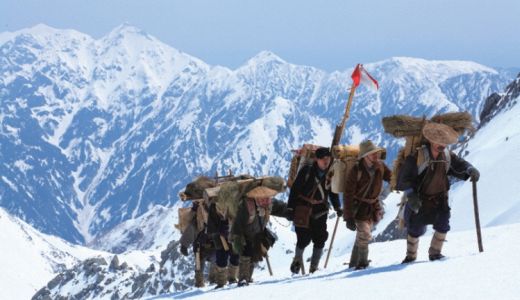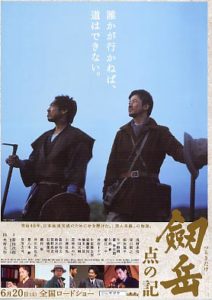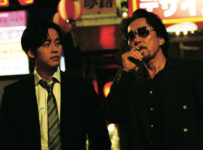Prior to the availability of handheld GPS, people used to rely on these things called maps and surveying to find their way around the world. It sounds like some kind of madness, but apparently they didn’t have the Internet in those days either. (It’s ok, we can say what we like about them here: they’ll never know). In order to plot out these so-called maps, surveyors would have to use carefully places survey stones, often requiring treacherous climbs to the peaks of mountains to get an accurate representation of the topography. In early twentieth-century Japan, one of the last great mountains to be opened was Tsurugi-dake or Mt. Tsurugi. With its sheer cliff faces and 2,999 m (9,839 ft) height, it is known as the “most dangerous mountain” for climbers.
It’s the early part of the 20th century, and the Japanese government wants their maps in order. With a group of amateur mountain climbers eyeing off the peak, an army survey party is ordered to be the first to the peak and claim the honours for the military. Yoshitaro Shibasaki (Tadanobu Asano, Villon’s Wife) leads up the army team, seeking out the help of villager Chojiro Uji (Teruyuki Kagawa, 20th Century Boys and Dear Doctor), they survey the mountain range before taking the rest of the team towards the top in a dangerous race for glory.
As a cinematic achievement, The Summit is phenomenal. Choosing not to use a single frame of computer graphics, veteran cinematographer Daisaku Kimura shot The Summit: A Chronicle of Stones (劔岳 点の記) shot the film in actual mountains over 200 days to give the film a sense of realism and beauty. This schedule was apparently quite gruelling on the cast and crew, often shooting at 3,000 meters above sea level with a wind-chill factor of -40 degrees Celsius. That’s cold people. The results are simply breathtaking, with every other shot of a mountain range, a pristine blue-skied landscape or brilliant white slopes of snow. It is a side of Japan rarely seen on film, and perhaps this is why it is so startling. The film spans the seasons, so we truly get a sense of the majesty of the Japanese mountain ranges, and how many different types of natural beauty there are packed into this small island nation.
Renaissance man Tadanobu Asano gives a terrific performance as the stoic Asano, and much of this is the terrific interplay he has with Kagawa, who won Best Supporting Actor at the 33rd Japan Academy Awards for his performace. Both actors appear to be in every Japanese film at the moment, with Asano and Kagawa in Festival stablemates Villon’s Wife and Dear Doctor respectively). Indeed, Asano is due to appear in the Hollywood superhero movie Thor next year, and it may only be a matter of time before Japan loses him forever to the lure of Tinseltown. Mind you, it hasn’t stopped crossover actors like Ken Watanabe (The Last Samurai, Batman Begins): he snatched the Best Actor award from Asano for his performance in The Unbroken. Asano, by the way, has a second and third successful ‘other’ life as a musician and artist, but it is unlikely he will ever have to quit his day job.
Unsurprisingly, Kimura won Best Director for The Summit: A Chronicle of Stones, one of the most impressively staged films in Japanese history. Along with Japan Academy Awards for Cinematography, Music, Lighting Direction and Sound Recording, it is easily the most technically capable Japanese film in years. While perhaps the whole thing gets a little overwhelming at times, and the climb goes incredibly slowly in some bits and baffling fast in others, this is a true piece of cinema, accomplishing only those things that can be done on the big screen.
The Summit: A Chronicle of Stones is playing at the 14th Japanese Film Festival nationally. It is due to play again at Melbourne on 6 December 2010.






No Responses